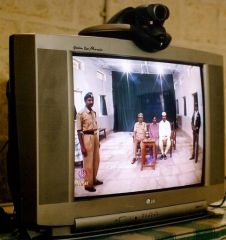Tele-justice bridges India's courts and jails

India's judicial system has sometimes been described as being slow and laborious. But information technology is bringing about a change in the country's judicial system that has provided the Indian government cost savings and enhanced security.
India has undertaken a nationwide project to connect jails and district courts across the country via a tele-justice or video conferencing system. With tele-justice, the accused can now be present in a court through a video link, established on ISDN lines, between the prison and the court.
Today, Indian states including Maharashtra, Andhra Pradesh, Tamil Nadu, Gujarat and Bihar have already introduced tele-justice. In Maharashtra, for instance, over 40 jails in and around Mumbai are connected to district level courts through video conferencing.
"For the national spread of tele-justice, we will see about 300 jails and 2,000 courts connected over video conferencing," Yugal Sharma, country manager for India and South Asia, Polycom (UK) India, told ZDNet Asia in an interview.
 With tele-justice, prisoners no longer need to be transported to the courtroom to stand trial. |
Polycom, a global player in unified collaborative communications, was engaged to deploy video conferencing equipment across various judiciaries and prisons in India. Andhra Pradesh was one of the first Indian states to introduce these electronic trails, connecting 15 district courts with prisons and installing 31 video endpoints.
"Our tele-conferencing systems allow judges, legal professionals, court officials, inmates and witnesses to seamlessly communicate face-to-face in real-time, as if they were in the same room," Sharma said. Today, Indian prisons alone contribute around 25 to 30 percent of Polycom's revenue generation.
Locking down cost, security benefits
There are risks attached to transporting convicts from prison to the courts. In addition, there are also costs in the form of deployment of policemen, security charges and transportation.
Tele-justice yields considerable savings on these fronts.
Sharma said: "In October 2006, when the tele-justice [system] was relatively new to India, Dr. Satyapaul Singh, Joint Commissioner of Police, had said that the 750 men and 45 vehicles required to escort prisoners, had been declared redundant due to tele-justice.
"Previously, the police department was spending US$8,827 (375,000 rupee) on a daily basis. With tele-justice, the expense came down to US$1,135 (45,000 rupee) per month per location," he said.
Worldwide, tele-justice has emerged as a secure way of carrying out legal procedures. By installing a video conferencing system at the courthouse as well as the prison facility, defendants can participate in all legal procedures without law enforcement having to shoulder the dangers associated with jail-to-courthouse prisoner transport.
Video-conferencing also helps connect more than one courtroom during a trial, and enables the use of more than one application. The system provides a simple user interface, which allows non-technical users such as judges and court staff, to easily operate and maintain the judicial video conferencing system.
The video conferencing equipment is mobile so it can be moved from room to room, and connects to the court's existing data infrastructure. Through video conferencing, timely actions and decisions can be taken during a trial.
In Singapore, the concept of tele-justice has been extended to what is known as "tele-visit". The tele-visit system allows inmates to communicate remotely with visitors at various Prisons Link Centrse (PLCs) located near train stations across the island-state.
The setup eliminates the need for visitors to physically go to prisons which are located in remote areas of Singapore, to communicate with the inmates and having to go through elaborate security procedures.
Tele-visit also uses video-conferencing technology and was first introduced in Singapore in March 1999.
Swati Prasad is a freelance IT writer based in India.